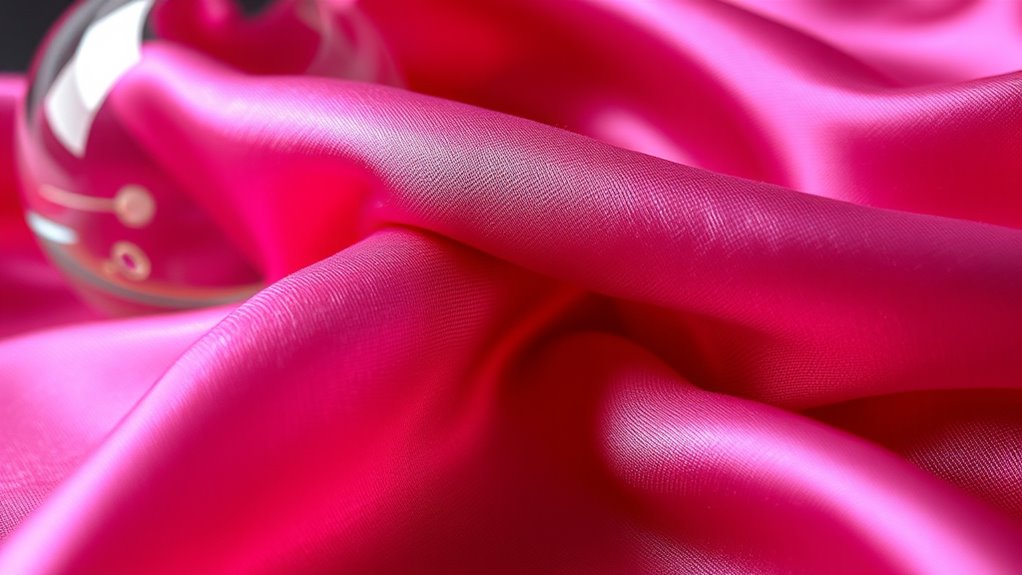Perkin’s mauve was accidentally created by William Perkin while trying to develop a medicinal compound, but it turned into a vibrant, durable dye. This discovery marked a major turning point in the chemical industry, proving that synthetic dyes could revolutionize colors in textiles and industry. It sparked innovations in chemistry and large-scale manufacturing, transforming fashion and industry growth. If you want to find out how this accident changed everything, keep exploring its story.
Key Takeaways
- William Perkin’s accidental synthesis of mauve revolutionized synthetic dye production and transformed the textile industry.
- Mauve was the first commercially successful synthetic dye, demonstrating the potential of chemical manufacturing.
- The discovery occurred during efforts to synthesize an anti-malarial drug, illustrating serendipity in scientific progress.
- Mauve’s success spurred further innovation in chemical dyes, supporting industrial growth and related sectors.
- The breakthrough helped establish chemistry as a key scientific discipline and fueled economic development.

Perkin’s Mauve marks a pivotal moment in the history of synthetic dyes, revolutionizing the textile industry and paving the way for modern chemistry. When you think about the impact of this discovery, it’s clear how it transformed not just fashion but also the entire chemical industry.
Before this breakthrough, most dyes came from natural sources like plants and insects, which limited colors and availability. The invention of synthetic dyes, starting with Perkin’s Mauve, changed that by providing vibrant, consistent colors that could be produced on a large scale. This shift was made possible through advancements in chemical synthesis, which allowed for the creation of dyes with properties previously unattainable from natural sources.
Natural dyes limited colors and supply before synthetic innovations like mauve.
This development didn’t happen in isolation; it was a direct result of the industrial revolution, which accelerated technological innovations and mass production methods. The industrial revolution created a fertile environment for scientific experimentation and industrial growth, making synthetic dyes a profitable venture.
As you explore the origins of synthetic dyes, you’ll see how Perkin’s accidental discovery sparked a chain reaction. William Perkin, a young chemist, was trying to find a synthetic drug when he accidentally created a purple dye—mauve.
This unexpected result quickly gained attention because it was unlike anything available at the time. The dye wasn’t only beautiful but also durable, making it perfect for textiles. Its success demonstrated that chemical synthesis could produce vibrant, stable colors cheaply and efficiently, which was a game-changer for the textile industry.
You can imagine the excitement that spread as factories began producing large quantities of mauve, reducing reliance on costly natural dyes. It also set the stage for further innovations, leading to a surge in synthetic dyes and chemical manufacturing.
The rise of synthetic dyes like mauve also played a crucial role in the broader context of the industrial revolution. It exemplified how scientific discoveries could boost industrial productivity and create new markets.
As you consider this, you realize that synthetic dyes did more than add color; they helped establish chemistry as a scientific discipline and fostered new industries. The success of mauve encouraged chemists to develop other synthetic dyes, which in turn supported the growth of related industries like textiles, fashion, and even pharmaceuticals.
This interconnection fueled economic growth and technological progress, shaping the modern chemical industry. Ultimately, Perkin’s Mauve was more than just a pretty color—it was the catalyst for a chemical revolution, transforming industries and society itself. The development of synthetic dyes laid the groundwork for future innovations in chemistry and industrial manufacturing.
Frequently Asked Questions
How Did Perkin Discover the Mauve Dye Accidentally?
You might find it fascinating that this dye’s discovery was an accidental reaction. While trying to synthesize quinine, you could have unintentionally created a new chemical reaction, resulting in a vibrant purple dye.
This unexpected outcome led to the discovery of mauve. By experimenting with coal tar, you witness how an accidental discovery can revolutionize the chemical industry and fashion, transforming a simple mistake into a groundbreaking innovation.
What Were the Initial Commercial Uses of Perkin’S Mauve?
Like a spark igniting a flame, the initial commercial uses of Perkin’s mauve revolutionized fashion innovation and showcased chemical breakthroughs.
You’d find it mainly in high-end textiles, especially in dresses and ribbons, creating vibrant, lasting colors that quickly captivated the market.
Its popularity made it a symbol of luxury and modernity, encouraging industries to explore new dyes and materials, transforming both fashion and chemical science forever.
How Did Mauve Influence the Development of Synthetic Dyes?
You see, mauve’s influence on synthetic dyes is profound. Its success marked a pivotal point in chemical innovation, showcasing how experimentation could lead to new materials.
This dye’s historical significance lies in inspiring chemists to develop a wide range of synthetic colors, transforming industries like textiles and fashion.
Mauve proved that chemistry could create vibrant, stable dyes, paving the way for modern chemical manufacturing and expanding the possibilities of color in everyday life.
Were There Any Health Risks Associated With Early Dye Production?
You might assume early dye production was entirely safe, but dye toxicity was a real concern. Workers faced health risks due to exposure to harmful chemicals, and safety protocols were limited.
The lack of proper protective equipment increased the danger, highlighting the importance of worker safety. These early industrial practices reveal how health risks, like dye toxicity, were often overlooked, emphasizing the need for regulations to protect laborers in chemical industries.
How Did Mauve Impact the Global Textile Industry?
You see, mauve sparked a textile revolution, transforming how fabrics looked and felt. It fueled a fashion evolution by making vibrant, lasting colors accessible, inspiring designers and consumers alike.
As a result, the global textile industry grew rapidly, embracing synthetic dyes to meet demand. Mauve’s success demonstrated the potential of chemical dyes, shaping modern fashion trends and expanding textile markets worldwide, leaving a lasting impact on style and industry practices.
Conclusion
You can’t help but feel awe when you realize how a single accidental discovery transformed an entire industry. Perkin’s Mauve didn’t just revolutionize dyes; it sparked a wave of innovation that changed the world. Think about it—what if that small mistake hadn’t happened? Sometimes, it’s the unexpected moments that ignite the greatest progress. Embrace curiosity and the surprises life throws your way—they might just lead you to your own extraordinary breakthrough.









